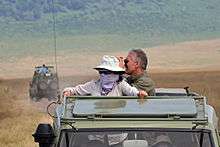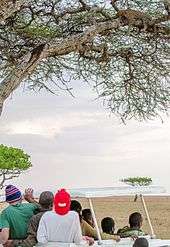Safari
A safari /səˈfɑːri/ (Swahili: safari) is an overland journey, usually a trip by tourists in Africa. In the past, the trip was often a big-game hunt, but today, safaris are often to observe and photograph wildlife—or hiking and sightseeing, as well.

Safari


The Swahili word safari means journey, originally from the Arabic adjective سفر (safar) meaning a journey,[1] travelling, touring or voyaging; the verb for "to travel" in Swahili is kusafiri. These words are used for any type of journey, e.g. by bus from Nairobi to Mombasa or by ferry from Dar es Salaam to Unguja. Safari entered the English language at the end of the 1850s thanks to explorer Richard Francis Burton.[2]
The Regimental March of the King's African Rifles was "Funga Safari", literally 'set out on a journey', or, in other words, pack up equipment ready for travel.
Funga safari, funga safari. Funga safari, funga safari. Amri ya nani? Amri ya nani? Amri ya Bwana Kapteni, Amri ya KAR.
Which is, in English:
Set out on a journey, Set out on a journey. On whose orders? On whose orders? On the order of the boss captain, On the order of the KAR.
On Kenya's independence from the United Kingdom, "Funga Safari" was retained as the Regimental March of the Kenya Rifles, the successor to the KAR.
History
In 1836 William Cornwallis Harris led an expedition purely to observe and record wildlife and landscapes by the expedition's members. Harris established the safari style of journey, starting with a not too strenuous rising at first light, an energetic day walking, an afternoon rest then concluding with a formal dinner and telling stories in the evening over drinks and tobacco.[3] The hunting aspect traditionally associated with the safari is said to have its origins in the early 1800s in the region of Évora, Alentejo, where villagers got together to hunt wild boar and reclaim land for farming.
Literary genre
Jules Verne's first novel Five Weeks in a Balloon published in 1863 and H. Rider Haggard's first novel King Solomon's Mines published in 1885, both describe journeys of English travellers on Safari and were best sellers in their day. These two books gave rise to a genre of Safari adventure novels and films.
Ernest Hemingway wrote several fiction and non-fiction pieces about African safaris. His short stories "The Short Happy Life of Francis Macomber" and "The Snows of Kilimanjaro" are set on African safaris and were written after Hemingway's own experience on safari. His books Green Hills of Africa and True at First Light are both set on African safaris.
Cinematic genre
The safari provided countless hours of cinema entertainment in sound films from Trader Horn (1931) onwards. The safari was used in many adventure films such as the Tarzan, Jungle Jim, and Bomba the Jungle Boy film series up to The Naked Prey (1965) where Cornel Wilde, a white hunter, becomes game himself. The safari genre films were parodied in the Bob Hope comedies Road to Zanzibar and Call Me Bwana. A short 15-minute helicopter safari was shown in Africa Addio where clients are armed, flown from their hotel and landed in front of an unlucky and baffled elephant. Out of Africa has Karen Blixen and famous hunter Denys Finch Hatton travelling, with Denys refusing to abandon home comforts using fine china and crystal and listening to Mozart recordings over the gramophone while on safari trip.
Fashion
The safari-style originated from British officers and the jackets worn during their campaigns in Africa.[4] There is a certain theme or style associated with the word, which includes khaki clothing, belted bush jackets, pith helmets or slouch hats, and animal skin patterns. Pith helmet was initially worn by the British military in the tropics and was adopted as streetwear between 1870 and 1950.[5] Conde Nast describes safari jackets as, "crisp drill cotton with pockets, buttons, epaulets, belt," and a part of Kenyan colonial style.[5]
For Theodore Roosevelt's 1909–1910 safari trip he was "outfitted" in safari-style by his friend Lord Cransworth during his post-presidential trip.[6] Lord Cranworth's firm Newland & Tarlton, is a luxury safari outfitter, creating safari-style clothing.[7] Additionally, other sources exist stating Roosevelt was outfitted by Willis & Geiger in 1908.[8] Hemingway, like Roosevelt on safari, chose to use British style rifles produced by Holland & Holland or Westley Richards.[5] The term safari chic arose after the release of the film Out of Africa.[9] Within Hollywood, celebrities like Grace Kelly and Johnny Weissmuller wore safari jackets.[5] Ernest Hemingway wore safari-style jackets, communicating a form of adventure also echoed in Hollywood.[5] According to Conde Nast, the Safari jacket is still a part of contemporary fashion.[5]
In the 2005 spring/summer edition of British Vogue an article titled,"World Vision: the grown-up approach to global style,” featured ‘‘haute safari’’ style clothing.[10] Contemporary American public figures such as Milania Trump have worn safari fashion. Mrs. Trump wore a safari-style dress and jackets during her 2018 trip to Africa.[11] On this trip Mrs.Trump went on a safari in Kenya, she wore a pith helmet. Some have criticized the choice as evoking colonial ideals.[11] In 2014 Harper's Bazaar announced trend alerts featuring animal prints and “safari sleek" style.[12] Couture designers in their 2015 fashion shows featured variations of safari-style in their collections. Designer Yang Lei featured a silk safari-style evening gown in his Spring/Summer collection during Paris fashion week.[13] Alexander Wang's collection focused on a variety of white shirts, including a safari-style white shirt dress.[14] The New York Times described designer Alberta Ferretti's 2015 daywear collection as "safari-sleek."[15]
In John Molloy's history of the leisure suit, he details that safari-style originated from British Officers wearing their uniforms outside military uses as"a status symbol, but only in casual settings."[16] Molloy stated in 1975 that it continues to be a form of casual menswear.[4] Alternatively, in Malindi Kenya, professional wear in the 1990s included safari-style clothing.[17] Yves Saint Laurent's 1967 Africa collection featured the "Saharienne" safari jacket.[18] In later collections, Yves Saint Laurent produced an iconic safari top.[18] According to Harper's Bazaar, the collection was "a fantasy of primitive genius."[19] On the other hand, differing fashion historians believe He had the gift of borrowing from one culture without being condescending to the other.[19]
Safari chic, not only included clothing but also interior design and architecture.[20] Safari-style interiors feature African decor,[21] various hues of brown, natural materials,[22] animal print furniture, rugs and wallpaper.[23] In 2005 Architectural Digest released a list of luxurious safari camps.[24] Newland, Tarlton & Co. Furniture Collection, creates luxury safari-style furniture in featured safari camps, hotels and private homes.[25] Safari fashion also extends to fragrance collections by American designer Ralph Lauren; The Safari fragrance created in 1990 was advertised as "a floral aroma with a light breeze scented by grasses, freedom, and the romance of vast open spaces."[26]
See also
References
- Hans Wehr Arabic-English Dictionary
- "safari". oed.com. Retrieved 2 December 2014.
See also: "safari in English corpus, 1800–2000". Google Ngram Viewer. Retrieved 2 December 2014. - pp.6–7 Balfour, Daryl & Balfour, Sharna Simply Safari Struik, 2001
- Cunningham, Patricia. ""Dressing for Success: The Re-Suiting of Corporate America in the 1970s"". Twentieth-Century American Fashion: 191–208.
- Wrong, Michela. "A Brief History of Safari Style". Condé Nast Traveler. Retrieved 18 April 2020.
- "Hunter-Conservationist or... Jekyll and Hyde?". Time. Retrieved 18 April 2020.
- Adams, Jonathan S.; McShane, Thomas O. (1996). The Myth of Wild Africa: Conservation Without Illusion. University of California Press. ISBN 978-0-520-20671-7.
- "The Fashion Survivalist". Los Angeles Times. 31 October 1996. Retrieved 18 April 2020.
- p.175 Bickford-Smith, Vivian & Mendelsohn, Richard Black and White in Colour: African History on Screen James Currey Publishers
- Kopnina, Helen (1 December 2007). "The World According to Vogue: The Role of Culture(s) in International Fashion Magazines". Dialectical Anthropology. 31 (4): 363–381. doi:10.1007/s10624-007-9030-9. ISSN 1573-0786.
- Friedman, Vanessa (8 October 2018). "Melania Trump: Out of Africa, Still in Costume". The New York Times. ISSN 0362-4331. Retrieved 18 April 2020.
- "Shop The Bazaar: Safari Sleek". Harper's Bazaar. 4 November 2014. Retrieved 18 April 2020.
- Friedman, Vanessa (4 March 2015). "Slouching Toward Versailles". The New York Times. ISSN 0362-4331. Retrieved 18 April 2020.
- Friedman, Vanessa (2 October 2015). "Alexander Wang's Finale at Balenciaga". The New York Times. ISSN 0362-4331. Retrieved 18 April 2020.
- Friedman, Vanessa (24 September 2015). "Fendi and Ferretti Find a New Muse". The New York Times. ISSN 0362-4331. Retrieved 18 April 2020.
- Cunningham, Patricia (2008). ""Dressing for Success: The Re-Suiting of Corporate America in the 1970s."". In Twentieth-Century American Fashion.
- Kratz, Corinne. "Kenya". Bloomsbury Fashion Central.
- Loughran, Kristyne (21 April 2015). "The Idea of Africa in European High Fashion: Global Dialogues". Fashion Theory. doi:10.2752/175174109X414277.
- Loughran, Kristyne (21 April 2015). "The Idea of Africa in European High Fashion: Global Dialogues". Fashion Theory: 243–271 – via Taylor & Francis Online.
- Gibbs, Bibi Jordan Safari Chic: Wild Exteriors and Polished Interiors of Africa Smith Publisher, 2000
- Alexander, Robyn (2007). The New Safari: Design, Decor, Detail. Quivertree Publications. ISBN 978-0-9802651-0-1.
- "21 Marvelous African Inspired Interior Design Ideas". Architecture Art Designs. 26 January 2014. Retrieved 18 April 2020.
- Clark, Emily A. "Decorate Your Home in African Safari Style". Condé Nast Traveler. Retrieved 18 April 2020.
- Sessa, Andrew. "Best New African Safari Camps". Architectural Digest. Retrieved 18 April 2020.
- Safaris, Donald Young (3 December 2014). "Kenya's Oldest Luxury Brand". Newland Tarlton Safaris by Donald Young. Retrieved 18 April 2020.
- Sims, Shari (2010). ""Fragrance as Fashion: So Much More Than Perfume."". In Berg Encyclopedia of World Dress and Fashion: Global Perspectives.
External links
| Look up safari in Wiktionary, the free dictionary. |
| Wikivoyage has a travel guide for African flora and fauna. |